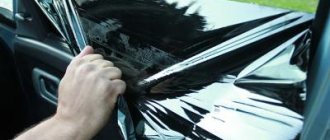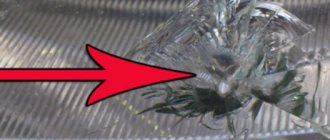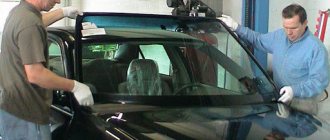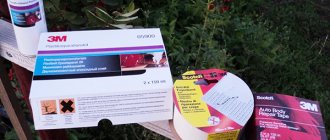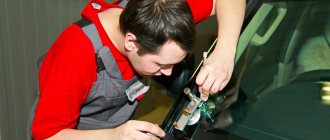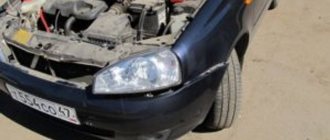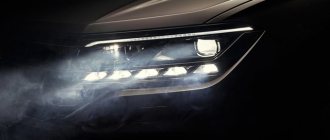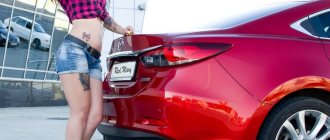Types of sealants
Special sealing compounds for headlights have a very specific purpose. They are used for minor repairs and installation of automotive optics made of transparent plastic or glass in order to obtain the most airtight connection.
Waterproof sealants perform the following tasks:
- prevent the penetration of water, air and dirt into the device;
- eliminate the appearance of condensation and a decrease in the quality of lighting;
- minimize the risk of damage to the diffuser and other metal elements;
- ensure strong joining of parts without the risk of peeling off.
In car stores, sealant for gluing headlight glasses is a popular product, because optics often fail and are the first to deteriorate during accidents. Most of these products are suitable not only for materials for making headlights: sealants perfectly glue wood, leather, fabrics, ceramics, and many are used for metal.
Sealing agents can have different compositions, but most of them are sold in finished form and are single-component.
Silicone sealants
Products containing silicone are widely used in the installation of headlights, lanterns, and car windows. They are created on the basis of rubber and its subtypes (siloxanes, fluorosiloxanes and others), and represent a transparent elastic mass. Silicone sealants also contain vulcanizers, which impart strength and elasticity like rubber, ensuring no damage when in contact with water.
Typically, silicone compounds are used to seal cracks up to 6 mm deep or glue various parts together to seal joints. They help eliminate minor defects and unevenness of the base, easily withstand heating up to +250 degrees and above (products with the addition of copper - up to +375 degrees), and do not deteriorate from temperature changes. The big disadvantage of silicone is its poor tolerance to petrochemicals and a number of other substances that are used in cars . Therefore, silicone sealants can be used where there is no contact with such liquids.
Polyurethane compounds
Products with polymers based on urethane groups are considered the most popular for the repair and installation of optics. Car enthusiasts prefer them for their versatility, because sealants are excellent for gluing and protecting many body and working parts of a car. Their properties are:
- high degree of adhesion with most known materials - plastic, glass, ceramics, rubber, wood, metal;
- excellent moisture resistance, air tightness;
- work in a wide temperature range, tolerance of changes from -60 to +80 degrees or more;
- long service life (up to 25 years);
- resistance to petrochemicals, weak acids, alkalis, other aggressive substances, as well as microbes, fungi, mold;
- uniform filling of even small cracks and seams, the ability to glue optics of any geometry;
- no shrinkage after polymerization.
Polyurethane compounds, after hardening, have slightly less elasticity than silicone ones. Because of this hardness, they are not recommended for use on connections subject to strong vibration, although they are good for headlights. Also, sealants are not suitable for installing dismountable joints: they are so strong that removing them will be problematic.
Sealants contain toxic solvents, so safety precautions must be strictly observed when applying and drying. With prolonged exposure to temperatures above +100...+120 degrees, the sealant layer is destroyed, which must be taken into account during operation.
Anaerobic compounds
Such products harden only when contact with oxygen ceases, maintaining their plasticity in air. They can be slowly applied to the parts and pressed tightly together, which is convenient for the craftsman. But in a vacuum, the process of rapid polymerization begins, as a result of which a strong seam is formed in a couple of minutes. Anaerobic sealants do not deteriorate at temperatures ranging from -80...+175 degrees, and are resistant to:
- fuel;
- oils;
- antifreeze;
- alkalis;
- weak acids.
The products create a reliable cushioning layer and help mount optics, front and rear windows, as well as seal body joints, threaded connections, and flanges. After hardening, a hard, durable plastic is formed at the site where the composition is applied, which lasts a long time, does not deform, does not shrink or expand. The ease of use is beyond doubt - there is no need for quick application, no physical effort for gluing, safety for humans and the environment.
Heat-resistant sealants
These compounds are characterized by increased strength and lack of reaction to high temperatures (usually up to +375 degrees). They are rarely used for repairing and installing headlights, because such connections are not subject to thermal stress. The finished seam is not afraid of shocks, shocks, vibrations, water and aggressive substances. The disadvantages of heat-resistant sealants are increased cost and long polymerization (8-12 hours until completely dry).
Types of sealants for headlights
The compositions differ primarily in the raw materials from which they are made. This determines their properties and provides certain characteristics. Most often, there are 4 types of options in stores; it is worth examining each of them separately.
The composition must be specifically designed for gluing headlight glasses.
Polyurethane compounds
Polyurethane provides high strength after hardening. Most often it is used to seal cracks and damage. Some even glue in whole pieces of glass if they need to go urgently. The main features of this variety are:
- High adhesion to smooth surfaces. The sealant adheres well to the glass and does not fall off under the influence of vibrations, temperature changes and other unfavorable factors.
- The composition does not allow moisture to pass through, therefore it protects the headlight from its penetration and prevents the glass from fogging from the inside.
- The service life is at least several years. And with high-quality application, polyurethane sealant can retain its properties for decades.
- Repairs can be carried out even at temperatures other than the highest. Thanks to this, if necessary, it will not be difficult to seal the headlight directly on the street if there is no garage or the glass was damaged on the road.
- After polymerization, the polyurethane mass is not afraid of exposure to oil, fuel, alcohol-containing liquids, road reagents, etc.
The polyurethane version is very strong and durable.
Due to its fluidity, even small parts can be glued together efficiently.
The main disadvantage is low heat resistance . If the headlights get very hot, then you should not use polyurethane sealant. It is also unsafe for human health before it hardens, as it emits dangerous fumes.
Anaerobic options
Anaerobic compounds are ideal for urgent repairs.
This product group has its own characteristics and is used in some cases when its properties are suitable:
- The product has a liquid consistency, which imposes certain restrictions on its application.
- It is used for minor damage when other types of compounds simply will not penetrate. You can carefully fill the crack and thereby strengthen it or seal a tight joint.
- No protective equipment is needed during operation. The composition is carefully applied to the desired place, after which the elements must be pressed tightly against each other and held there for some time.
High fluidity creates problems during repairs . It is necessary to dose the liquid very accurately and ensure that it does not leak and damage the reflector or other elements of the headlight.
Heat-resistant sealants
Heat-resistant compounds can withstand any temperature.
This solution is distinguished by high strength; after polymerization, the composition can withstand temperatures up to 400 degrees or even higher. This extreme durability is needed for headlights that get very hot during operation and are turned on very often. But besides heat resistance, this type has other advantages:
- The frozen mass is characterized by high strength and long service life. It does not lose its ductility for years and provides reliable connection of both the same and different materials.
- Does not peel off under constant vibrations and withstands moderate deformation loads well. Technical and other aggressive liquids do not spoil the mass and do not impair its properties.
- Most often this is a two-component composition that is prepared before use. It can be both plastic and quite hard. Due to this feature, the sealant has a long shelf life, since it does not harden until a hardener is added to the composition.
By the way! After application, you need to leave the headlight for at least 8 hours so that polymerization takes place and the finished mass sets well. Therefore, repairs are best done at night or when there is time to spare.
Silicone compounds
The basis for the manufacture of this group of products are natural or synthetic rubbers. Due to this, the mass turns out to be plastic and resembles dense rubber after hardening. Most often, the composition contains additives to protect against ultraviolet radiation. But such options do not tolerate exposure to technical fluids, especially alcohol-containing ones. When choosing, you need to pay attention to this point. The features are:
- This is the cheapest type of composition, so they are used most often. Silicone-based sealant can be purchased at any auto store.
- The adhesive properties are high, and the consistency is quite thick, which allows you to securely attach the headlights to the body. Silicone is easy to apply; it does not spread and does not set immediately, which allows you to set the optimal position and fix the glass.
- Heat resistance varies, usually ranging from 100 to 300 degrees. It is better to select an indicator with a margin to eliminate any problems.
Silicone options fill all voids and reliably glue the elements together.
Another advantage of silicone is that, if necessary, it is much easier to separate it than other types. It does not harden too much and cuts well with a sharp knife, making it easy to remove the glass if needed later.
Rating of the best sealants
To work with automotive optics, you need to purchase high-quality products so as not to experience problems with the functioning of lighting devices.
ABRO WS 904
ABRO WS 904 sealant is one of the most popular according to user requests. It is sold in the form of adhesive tape in rolls of different sizes, made on the basis of vulcanized polyisobutylene, a derivative of artificial rubber.
This butyl headlight sealant is highly elastic and easy to use - you just need to cut a piece of tape of the required size, stretch it and stick it to the surface. It only takes a few seconds to connect the ends of the tape to each other - the polymerization process occurs quickly. At low ambient temperatures, it is recommended to additionally heat the sealant with a hair dryer.
The advantages of ABRO WS 904 tape are as follows:
- low consumption - the packaging is enough to completely seal a set of headlights;
- ease of installation - the tape does not stick to your hands, is pliable, can be easily cut, and stretches to achieve the desired thickness without effort;
- high degree of adhesion to most materials;
- absence of toxic emissions and unpleasant odor;
- strength, long service life after hardening, reliability and complete tightness of the seams.
Dow Corning 7091
It is recommended to purchase this sealant when working with dissimilar materials that have unequal coefficients of thermal expansion. It is capable of creating high-quality joints at the junctions of glass and metal, glass and plastic, and metal and plastic, so it is perfect for installing and repairing automotive optics.
Dow Corning 7091 Silicone Sealant is a one-pack, ready-to-use product that is both durable and flexible. The sealant is suitable not only for working with car headlights, but also for installing LED lamps, various electronic devices and complex mechanisms. After polymerization, the formed seam will reliably seal the joint, while it is not destroyed by temperature changes and can be used at -55...+185 degrees. The sealant is easy to further process, if required, and is a good dielectric.
DoneDeal DD6870
The composition of DoneDeal DD6870 refers to polyurethane sealants, includes urethane groups, petroleum products, various polymers, adhesion enhancers and other additives.
It can be used for installation and sealing purposes:
- headlights;
- glass;
- lanterns;
- lamps;
- hatches;
- instead of gaskets.
The sealant dries completely within 15–30 minutes after application, has high strength seams, good adhesion to most materials, and does not crack under the influence of vibration or shock. The product is characterized by moisture resistance and works without loss of properties in the temperature range from -60 to +270 degrees.
3M PU 590
3M PU 590 sealant is produced in the USA, has a polyurethane base, and is packaged in convenient tubes of 300–600 g. It does not tolerate high temperatures (withstands up to +100 degrees), so it is not used on hot car components. The product polymerizes quickly (in 25–30 minutes), does not react to acids, alkalis, solvents, is resistant to moisture and UV radiation, and reliably connects even dissimilar materials. Once cured, the sealed joint can be painted over with most automotive paints.
Emfimastic PB
This brand of adhesive-sealant is produced in France and contains polyurethane groups and various improving additives. Ethermastic glues homogeneous and dissimilar materials as reliably as possible, ideal for installation and repair of automotive optics. The composition is odorless, hardens in half an hour, does not shrink, and does not crack over time. It is not harmful to humans, has no unpleasant odor, and can be used even indoors. To apply this flexible sealant you will need a hand or air gun.
Main types of sealants
Headlight sealant is available in different forms and with different base substances. The technical characteristics depend on the type of composition. To understand which sealant to use to glue headlights, you need to study each one.
Headlight sealant is available in different forms and with different base substances.
Silicone
The silicone type of composition can be used as a sealant for gluing the glass of front and rear headlights. Suitable for working with glass sunroofs and other car parts. The product has a good level of adhesion, resistance to vibration and high temperatures. However, it is not resistant to chemicals.
Used on plastic and metal surfaces.
The product has a good level of adhesion, resistance to vibration and high temperatures.
Polyurethane
The difference from the previous type is exposure to aggressive substances. Resistant to mold, mild acids and alkalis. The liquid consistency is well distributed over the base, creating a barrier against the penetration of external elements into the headlight.
Polyurethane sealant for headlights does not shrink, but does not perform well during vibrations due to poor elasticity. A long service life is ensured, which can reach 25 years.
Resistant to mold, mild acids and alkalis.
Anaerobic
The setting starts when the parts are connected, this simplifies the process of applying the composition. It is resistant to mechanical loads, vibrations, high temperatures, aggressive and chemical substances.
Resistance to mechanical loads, vibrations, and high temperatures is demonstrated.
Heat resistant
Thermal sealants for headlights are produced in two components. Before use, the substances from the tubes are mixed together. The purpose of the compositions is for connecting halogen lamps, where heating reaches +300 degrees. There are species that can withstand up to +400 degrees. Withstands chemicals. The layer dries in 8-12 hours.
Withstands chemicals.
Butyl
Butyl headlight sealant comes in thick strips. They are resistant to chemical elements, aggressive environments, and vibrations. Durability is 7-10 years.
The tape material is distributed over the surface, then the glass is pressed. A plus is the lack of need to wear PPE when working, due to its harmlessness.
They are resistant to chemical elements, aggressive environments, and vibrations.
Instructions for use
Before using any product, regardless of its shape and type, the surface must be carefully prepared. The headlight and base are cleaned of dirt and old sealant (if any), degreased, while working carefully so as not to damage the lens. Then apply the product in a thin layer, following the instructions:
- liquid formulations are distributed using a dispenser;
- paste-like products are squeezed out using a glue gun;
- The tapes are cut and glued by hand.
If the sealant is not anaerobic, the parts must be pressed well together. When the room is cold, it is recommended to warm up the seam and glued elements with a hair dryer. Afterwards you need to wait until it dries completely (usually no more than 30 minutes).
Classification of auto sealants
The maintainability of different materials is not the same, and to varying degrees. Glass in this case stands apart. The reason is known - the specific physical properties of this material, primarily its fragility. Transparent plastic, used as an alternative to glass, is more affordable in this regard; gluing its individual parts together is not a problem. But the feasibility of such an operation is questionable - plastic optics are much cheaper than glass ones. However, broken glass and plastic headlights can be repaired using waterproof adhesives called sealants. They are characterized by their ability to provide a high-quality and durable connection of the bonded surfaces due to excellent adhesive properties, guaranteeing ideal sealing of the seam against moisture and air.
But the choice of sealant for car headlights is complicated due to the presence of several varieties. Moreover, many compositions are universal, capable of gluing most other materials used in the automotive industry, from wood and metal to leather.
But we are interested in glass. It all depends on the physical and chemical properties of a particular sealant. However, “straight” hands won’t hurt either - the lack of perfect tightness of the treated seam means that moisture and air - the main components of the metal oxidation reaction - will inevitably get inside the optical device. In addition, due to the higher temperature inside the headlight, this moisture will settle on the surface in the form of condensation, significantly degrading the quality of lighting.
So what sealant should you use to glue car headlights? Below we will consider this issue in more detail, but for general development, we note that one-component compositions are the most common. In retail sales they are present in a form that is almost completely suitable for immediate use without the need to perform any complex manipulations. If you purchase sealant in the form of a thick liquid, in most cases the packaging container is equipped with a dispenser. Adhesive compositions in paste form require dilution, while the necessary liquid is included, there is no need to buy it separately.
There are four main groups of sealants, differing in their component composition: silicone, polyurethane-based, heat-resistant, and anaerobic. Let's consider their features, characteristics, disadvantages and advantages.
Silicone sealants
For this material, the defining physical and chemical characteristics are viscosity, high density and elasticity in non-polymerized form. The main components of the silicone composition are natural rubbers of various natures (organosilicon, siloxane, fluorosiloxane). There are also vulcanizing additives that give the material the necessary elasticity and elasticity, like rubber, which allows you to reliably glue and at the same time seal the seam being processed. This adhesive composition, in addition to its main purpose, can be used to seal defects in glass and plastic surfaces up to 6 mm deep, that is, as a putty.
Silicone auto adhesive Donedeal DD6870
Silicone sealant does not lose its properties after polymerization when exposed to temperatures of about 250ºC, and its heat-resistant version is one hundred degrees higher, which is important when using high-temperature lamps. Adding copper to the composition increases thermal resistance by several tens of degrees.
We recommend: How to easily unscrew the crankshaft pulley - simple instructions
The main disadvantage of silicone transparent sealant for gluing headlight glasses is its chemical susceptibility to materials containing ethylene glycol, and this includes antifreeze, all types of oils, and even gasoline. So it is not allowed to use such an adhesive composition in places where there is a possibility of technical liquids getting into the seam.
Polyurethane sealants
Due to the above reasons, the scope of application of silicone compounds is limited, unlike polyurethane ones. They are the most common when performing a large number of repair work that requires the use of reliable glue.
If you need to glue the glass of a headlight, such a sealant will be no worse than silicone, since it has excellent adhesive properties, ideal water resistance and air tightness. The polymerized sealant layer is so hard that it is not recommended for gluing demountable joints.
Other advantages of polyurethane adhesive composition:
- the ability to carry out restoration work in a wide temperature range (-60ºС - +80ºС);
- the ability to maintain its adhesive properties for 25 years;
- resistance to aggressive substances, including all types of technical fluids used in the car;
- immunity to biological factors (mold, fungus, bacteria);
- excellent elasticity in the non-polymerized state, allowing gluing surfaces of any geometry with uniform filling of both seams and other defects, without shrinkage;
- Cured polyurethane sealants, despite their high hardness, have the ability to withstand deformation effects. In particular, according to test results, silicone seams do not crack during seismic shocks, estimated at 5 points on the Richter scale.
There were some downsides too. The most significant drawback is the toxicity of some components of the original composition, so when performing work it is necessary to adhere to appropriate safety measures. But after hardening, the sealant becomes absolutely safe, since all harmful substances are bound at the molecular level.
Another disadvantage of silicone adhesive is its inability to withstand prolonged exposure to temperatures above 120ºC, so this headlight sealant is not used for gluing surfaces exposed to such high temperatures.
Disposal of this material is an expensive procedure; the cost of such an adhesive composition is higher than that of acrylic and silicone analogues. Nevertheless. This material, when it comes to repairing headlights, has been and remains the most in demand.
Polyurethane sealant Emfimastic RV
Anaerobic sealants
One of the most important properties of anaerobic sealants is their ability to maintain the original plasticity unchanged for any length of time, but for this, the treated seam must be in constant contact with air. As soon as the access of oxygen stops, the irreversible process of polymerization immediately begins. Its speed depends on the composition of the sealant, but because of this feature, this type of adhesive is used primarily to form a gasket layer, and also as a sealant for seams, threaded connections, joints, flanges, etc.
In terms of resistance to aggressive materials and environments, anaerobic compositions are unrivaled, and the polymerized layer is not afraid of exposure to temperatures in the range of 90-175ºС.
We recommend: How to install heated mirrors with your own hands?
In its original form, it is a liquid, for rapid hardening of which it is necessary to limit the access of air (for example, by tightly pressing the surfaces being treated). It is not entirely convenient to seal headlights with such a sealant due to their complex geometry, but if you get used to it, the result will meet your expectations. When hardened, anaerobic sealant becomes a substance resembling plastic, but harder, does not dry out over time and does not expand when exposed to moisture.
The main advantage of such an adhesive composition is polymerization under natural conditions, without the need for external catalyst action. Unlike its polyurethane counterpart, this sealant is absolutely safe and does not require special disposal.
Heat-resistant sealants
The main characteristic of heat-resistant adhesive materials, as their name suggests, is the ability not to collapse under the influence of high temperatures (about 380-400ºС). The strength characteristics of the polymerized layer are high, guaranteeing absolute resistance to deformation and vibration loads. To install the headlight glass on such a sealant, two-component compounds are used in a solid or paste state. The only drawback of high-temperature adhesive-sealant is the long hardening time (8-12 hours).
Removing old sealant
Most often, when installing a new headlight, particles of the previous sealing compound are present on the base. Removing it can be a problem, especially if the product is polyurethane based. You must work carefully so as not to scratch the base or damage important elements. There are several ways to remove sealant:
- heat the dried composition with a hairdryer, and after softening, carefully remove it (it is important not to melt the plastic on the optic covers);
- scrape off particles of sealant with a sharp knife or a flat-blade screwdriver;
- wipe with solvent.
When installing headlights, it is better to use proven, reliable sealants and strictly follow the instructions for their use - in this case, the optics will last a long time and will not cause problems on the road.
How to remove old sealant from a headlight?
It happens that the silicone compound breaks down and loses its adhesion to the base, which prevents it from performing its sealing function. The old solution takes on an unsightly appearance, and dark spots often appear in the gaps. This is why it is so important to remove the old silicone and replace it with new one.
Old silicone can be removed mechanically using a special tool, such as a knife. Heat the silicone with a hairdryer or heat gun (it is important not to overheat, as the materials on which the silicone is applied can be damaged) and scrape it off with a knife. Next, use a chemical product that will remove any remaining old caulk and prepare the surface before adding new silicone. Such a product could be acetone, which effectively softens and dissolves both cured and uncured silicone.
